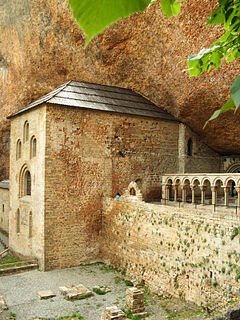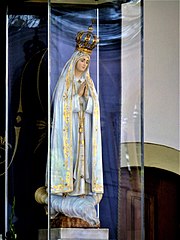 W
WThe culture of Portugal is a very rich result of a complex flow of many different civilizations during the past millennia. From prehistoric cultures, to its Pre-Roman civilizations, passing through its contacts with the Phoenician-Carthaginian world, the Roman period, the Germanic invasions of the Suebi, Buri and Visigoths, Viking incursions, Sephardic Jewish settlement, and finally, the Moorish Umayyad invasion of Hispania and the subsequent expulsion, during the Reconquista, all have made an imprint on the country's culture and history.
 W
WAdamastor is a mythological character created by the Portuguese poet Luís de Camões in his epic poem Os Lusíadas, as a personification of the Cape of Good Hope, symbolizing the dangers of the sea and the formidable forces of nature challenged and ultimately overcome by the Portuguese during the Discovery Age. Adamastor manifests itself out of a storm.
 W
WAn Arraiolos rug, Arraiolos tapestry, Arraiolos carpet or Portuguese needlework rug is an embroidered wool rug made traditionally in the small town of Arraiolos, Portugal, since the Middle Ages. They are inspired by Persian carpets.
 W
WA campino is a cattle herder in the Portuguese region of Ribatejo.
 W
WThe Portuguese Catholic Church, or Catholic Church in Portugal, is part of the worldwide Catholic Church in communion with the Pope in Rome, under the Portuguese Episcopal Conference. The Catholic Church is the world's largest Christian organisation. It is Portugal's largest religion and its former state religion, and has existed in the territory since the Iberian Peninsula was ruled by the Roman Empire.
 W
WChristianity has a strong tradition of pilgrimages, both to sites relevant to the New Testament narrative and to sites associated with later saints or miracles.
 W
WJogo do pau, 'lit. game of the stick' is a Galician and Portuguese martial art which developed in the regions along the Minho River: Minho, Trás-os-Montes, Pontevedra and Ourense, focusing on the use of a staff of fixed measures and characteristics. The origins of this martial art are disputed, but its purpose was primarily self-defence. It was also used to settle arguments and matters of honour between individuals, families, and even villages. While popular in the northern mountains, it was practically unknown elsewhere, and those who did practice it were taught by masters from the North of Portugal and Galicia.
 W
WThe José Saramago Foundation is a cultural private institution located in the Casa dos Bicos, in Lisbon (Portugal). A smaller branch has been opened in Azinhaga do Ribatejo, home village of José Saramago, the Portuguese Nobel Prize in Literature 1998. Founded by the writer in June 2007, its main institutional principles are to defend and spread the Universal Declaration of Human Rights, the promotion of culture in Portugal as well as in all the countries, and particular concerns about environmentalism.
 W
WLusotropicalism was first used by Brazilian sociologist Gilberto Freyre to describe the distinctive character of Portuguese imperialism overseas, proposing that the Portuguese were better colonizers than other European nations.
 W
WThe Macau Scientific and Cultural Centre, endowed with administrative autonomy and individual capital, is a public institute integrated within the internal administration of the Portuguese State, under the supervision of the Ministry of Science, Technology and Higher Education. The Centre’s mission is to produce, promote and disseminate knowledge about Macau as a platform between Portugal and the People’s Republic of China, as well as between Europe and Asia. The Centre is also a forum dedicated to studying and teaching the Chinese language and China’s culture and history, and a centre for scientific research and ongoing and advanced training, on international relations between Portugal and China, and between Europe and Asia. The Centre was created in 1995 by the initiative of the government in Macau in cooperation with the government of Portugal, and was inaugurated in 1999.
 W
WMadeira Day, celebrated in Madeira on 1 July, is a holiday marking the date when Portugal granted autonomy to Madeira. Although it is only officially celebrated in Madeira, Portuguese citizens and also Portuguese immigrants throughout the world celebrate this holiday.
 W
WThe Manueline, occasionally known as Portuguese late Gothic, is the sumptuous, composite Portuguese architectural style originating in the 16th century, during the Portuguese Renaissance and Age of Discoveries. Manueline architecture incorporates maritime elements and representations of the discoveries brought from the voyages of Vasco da Gama and Pedro Álvares Cabral. This innovative style synthesizes aspects of Late Gothic Flamboyant architecture with original motifs and influences of the Plateresque, Mudéjar, Italian, and Flemish architecture. It marks the transition from Late Gothic to Renaissance. The construction of churches and monasteries in Manueline was largely financed by proceeds of the lucrative spice trade with Africa and India.
 W
WThe Ministry of Culture is a Portuguese government ministry, responsible for issues related to the Portuguese culture. The current Minister of Culture is Graça Fonseca.
 W
WThe symbols of Portugal are official and unofficial flags, icons or cultural expressions that are emblematic, representative or otherwise characteristic of Portugal and of its culture.
 W
WOrfeão Universitário do Porto (OUP) ComM • ComIP is a Portuguese student Association linked to the University of Porto dedicated to choir singing and Portuguese culture. Originally founded on March 6, 1912 under the name of Orfeon Académico do Porto, following the French mouvement des orphéons, it is one of the few associations that gather students from all the Faculties of the University of Porto. It has undergone reorganizations in 1937 and in 1942, from where its current designation still lasts until today.
 W
WOur Lady of Fátima (Portuguese: Nossa Senhora de Fátima, formally known as Our Lady of the Holy Rosary of Fátima,, is a Catholic title of the Blessed Virgin Mary based on the Marian apparitions reported in 1917 by three shepherd children at the Cova da Iria, in Fátima, Portugal. The three children were Lúcia dos Santos and her cousins Francisco and Jacinta Marto.
 W
WThe Escola Portuguesa de Arte Equestre is a Portuguese institution dedicated to the preservation of the equestrian arts, in the Portuguese tradition. It is one of the "Big Four", the most prestigious classical riding academies in the world.
 W
WChristianity has a strong tradition of pilgrimages, both to sites relevant to the New Testament narrative and to sites associated with later saints or miracles.
 W
WThe Old Man of Restelo, also known as The Old Man of Belem, is a fictional character introduced by the Portuguese epic poet Luís de Camões in Canto IV of his work Os Lusíadas. The Old Man of Restelo is variously interpreted as a symbol of pessimism, or as representing those who did not believe in the likely success of the then upcoming Portuguese voyages of discovery. The character appears at the embarkation of the first expedition to India (1497), giving warnings about the odyssey that was about to happen.